If you're in search of a tropical plant with ornamental foliage that will give your space a tropical, greenery ambiance, then the peperomia plant is precisely what you need.
It can be argued that the tropical plants with their fleshy leaves and ornamental foliage have gone in and out of fashion for decades but are enjoying a surge of attention.
One thing is, however, for sure, peperomia is perfect for all spaces. It can add that tropical feel to all living spaces, such as on a desktop, shelf, or windowsill.
This post will center on some types of peperomia plants that will make perfect houseplants. Mind you, we can’t cover all species of the plant, seeing that there are over 1,500 species of peperomia.
Some popular peperomia plants are Peperomia obtusifolia (baby rubber plant) and Peperomia Argyreia (Watermelon Peperomia). Each variety shares different characteristics like thick, succulent-like oval leaves, rippled or striped green heart-shaped leaves, etc.
Table of Contents
What are Peperomia Plants?
Before we get into the different varieties of peperomia plants, it is essential we examine what exactly they are.
Peperomias are generally referred to as radiator plants because their roots absorb nutrients and moisture from air and water (known as perennial epiphytes).
In terms of taxonomy, these sets of plants belong to the family Piperaceae and have over 1500 species.
They are native to Central and South America and closely share some similarities with succulent plants, probably because of their thick foliage, which can store extra water.
Unlike succulents, they prefer high humidity and require more water than the average succulent plant.
Being perennial epiphytes, they have low nutrient requirements making them perfect for novice gardeners or plant owners.
They prefer warm conditions with bright sunlight and high humidity, which basically differs from succulents.
In terms of outlook and appearance, there are different variations. For instance, some variations have smooth, rippled, or puckered with heart-shaped or oval leaves.
However, most peperomias share a common similarity; they rarely produce flowers, especially when housed indoors.
For peperomias growing outside, they sometimes produce tiny flowers which resemble white or greenish spikes at the end of a long stem.
Why You Should Grow Peperomia Plants
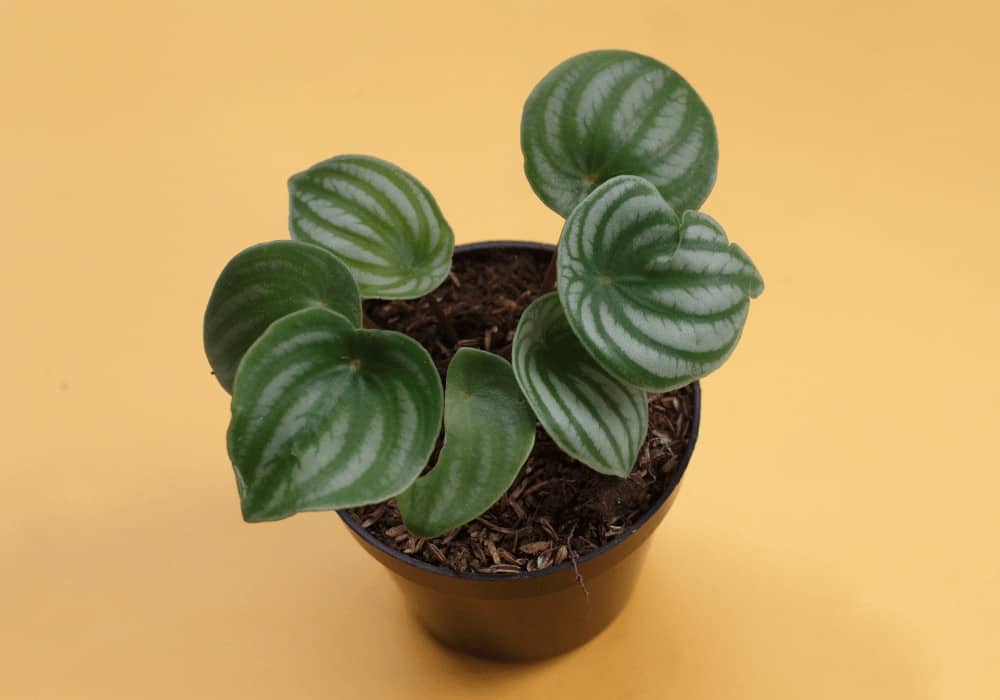
Looking for the right reasons to grow peperomia? Or maybe some sort of motivation to get an indoor plant?
Well, there are a thousand reasons why peperomia is the right houseplant for you! Here are just a few:
- Peperomias are high-tolerant plants with low nutritional requirements, which makes them perfect for novice gardeners. The undemanding plant can survive for a long time provided you don't overwater them.
- Peperomias can thrive in limited spaces since they are small plants.
- Peperomias typically thrive indoors.
- Peperomias are simply captivating from their stem patterns and leaf shapes, sizes, colors, textures, and growth styles.
- Many Peperomias are highly adaptive and can tolerate a range of light conditions.
- Most Peperomia varieties are extremely easy to propagate.
- Peperomia Plants grow slowly, giving you all the time you need to repot them.
- Peperomias are non-toxic to children and pets.
Types of Peperomia
When we talk about peperomia types, we refer to the large varieties of peperomia houseplants. Peperomia are versatile plants, and there is a variety that can suit every modern interior.
For instance, the Peperomia obtusifolia (baby rubber plant) with its thick, glossy rounded leaves will be perfect for an office space.
Below are some varieties of Peperomia Plants to spice up your décor.
1. Peperomia Obtusifolia (Baby Rubber Plant)
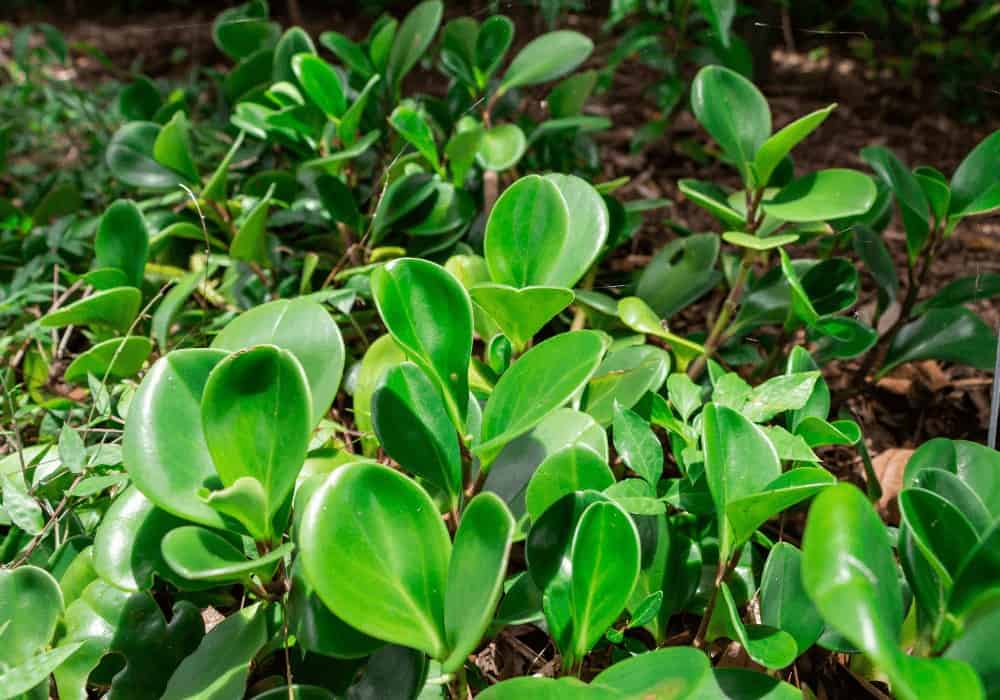
Also known as “pepper face peperomia,” the peperomia obtusifolia is one of the most popular varieties of peperomia plants. This variety has thick, glossy rounded leaves with tall upright stems.
When growing, it has a small, bushy succulent form with slightly concave leaves, creating a somewhat cupped shape. They can grow 30cm tall and thrives in bright light.
As mentioned earlier, most peperomia varieties rarely produce flowers which is the same for the baby rubber plant, especially when housed indoors. Outdoor Peperomia Obtusifolia might produce insignificant flowers.
In terms of care requirements, Peperomia Obtusifolia will thrive best in well-draining peat-based soil and under bright, indirect light.
Only water when the soil surface is dry and mist the leaves regularly to maintain an ideal humidity.
2. Peperomia Argyreia (Watermelon Peperomia)
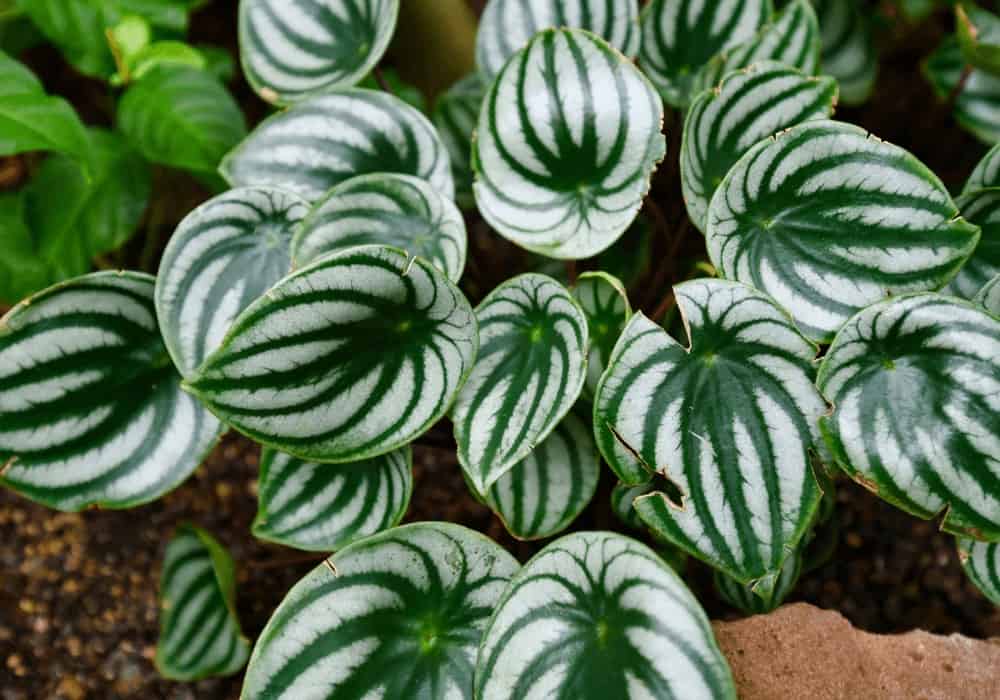
This variety of Peperomia should be at the same level as the Baby Rubber Plant in terms of popularity.
Just as the name suggests, the leaves of the Watermelon Peperomia resemble a watermelon with its off-center silver veins and red stems colored like the inside of a watermelon.
This plant grows into a bushy rosette, making it ideal for indoor settings, especially when grouped with other plants indoors.
It can be argued that the Watermelon Peperomia is not the easiest species for newcomers to keep, probably because of the succulent nature of its leaves.
However, with the proper care conditions, you won't have any trouble dealing with this variety.
When watering, let the top two inches of soil dry out before rewatering. This variety thrives in bright environments, high humidity and can also be drought tolerant. They rarely produce flowers, but when they do, it looks like greenish spikes.
3. Peperomia Rotundifolia (Trailing Jade Peperomia)
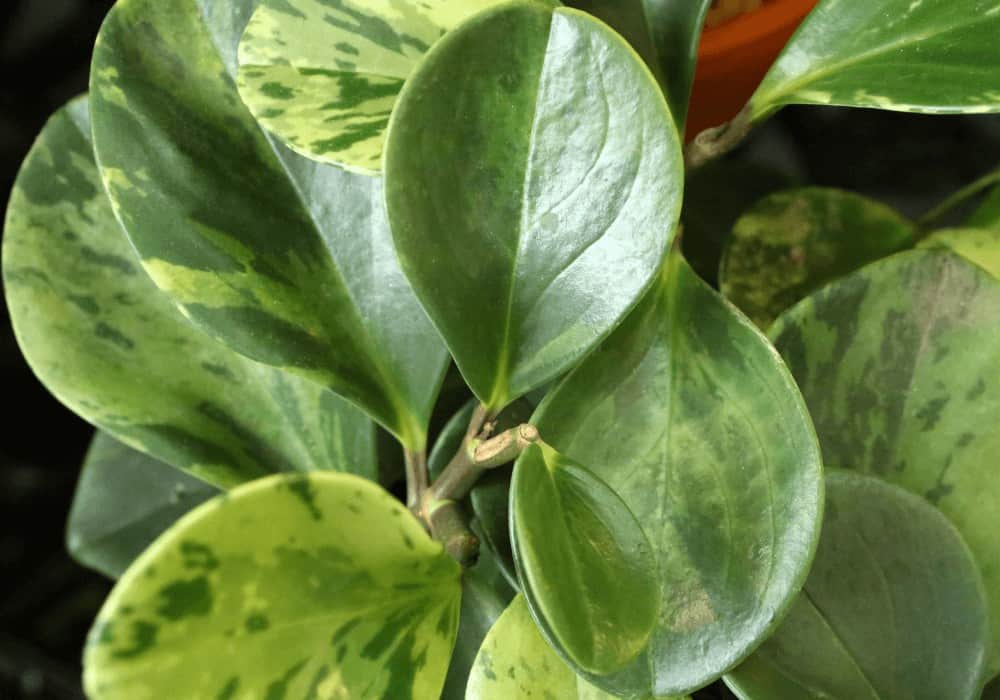
Just as the name ‘Trailing jade peperomia' suggests, this variety of peperomia plants is often mistaken for jade plants. It is also called Trailing Jade and Jade Necklace.
They have round, small, and fleshy leaves like that of a succulent plant. They are also part of the trailing peperomia variety with long stems that intertwine as they grow, giving them an almost bushy appearance.
Due to its trailing nature, its beauty is more significant when grown in a hanging basket.
This variety is native to South American rain forest. It's usually found crawling in the undergrowth and clinging to rocks and deadwood.
This variety is also relatively easy to tend to and thrive on moisture, warm temperatures, and shady conditions — only water when the soil surface dries and grows in well-draining peat-based soil.
4. Peperomia Prostrata (String of Turtles)
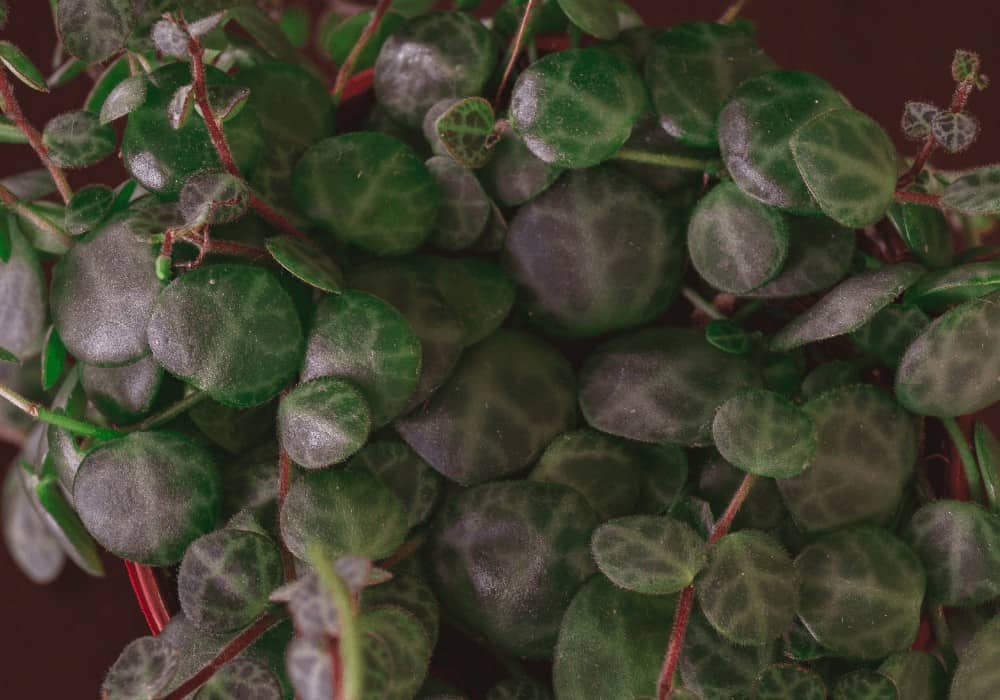
Just as the name ‘String of turtles’ suggest, this variety has light green veiny leaves which resemble a turtles shell. In addition, this variety is a slow grower, which probably points to its name.
This variety is characterized by long cascading strings of tiny circular leaves that can fall off quite quickly, making it perfect for growing in a hanging basket or spreading outwards on a desk or table.
String Of Turtles are sensitive to movements and shouldn't be moved around as much. In addition to this, they are also vulnerable to temperature fluctuations which might lead to leaf drop.
This variety will thrive in Well-draining soil and Moderate indirect light. It should also be watered sparingly and shouldn’t be repotted regularly because it is sensitive to movement.
5. Peperomia Angulata or Peperomia Quadrangularis (Beetle Peperomia)
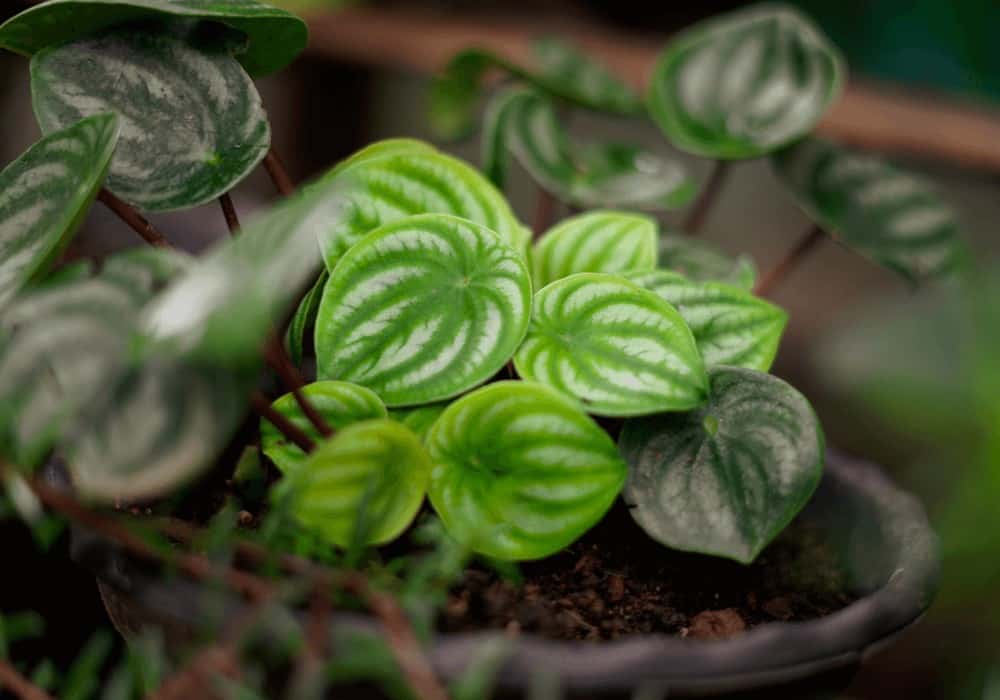
This variety belongs to the trailing peperomia plant variety and has succulent-like leaves and long trailing stems.
It shares certain similarities with the watermelon peperomia, with its dark green leaves striped with a light green pattern and reddish stems.
The Beetle Peperomia is a slow-growing epiphyte without extensive roots. It can thrive in an undersized pot and hanging baskets.
This variety is an excellent choice for beginner plant owners and will thrive with moderate, indirect light, or partial shade. It should be planted in well-draining, peat-based soil and only watered when the soil surface is dry.
6. Peperomia Caperata ‘Emerald’ (Emerald Ripple Peperomia)
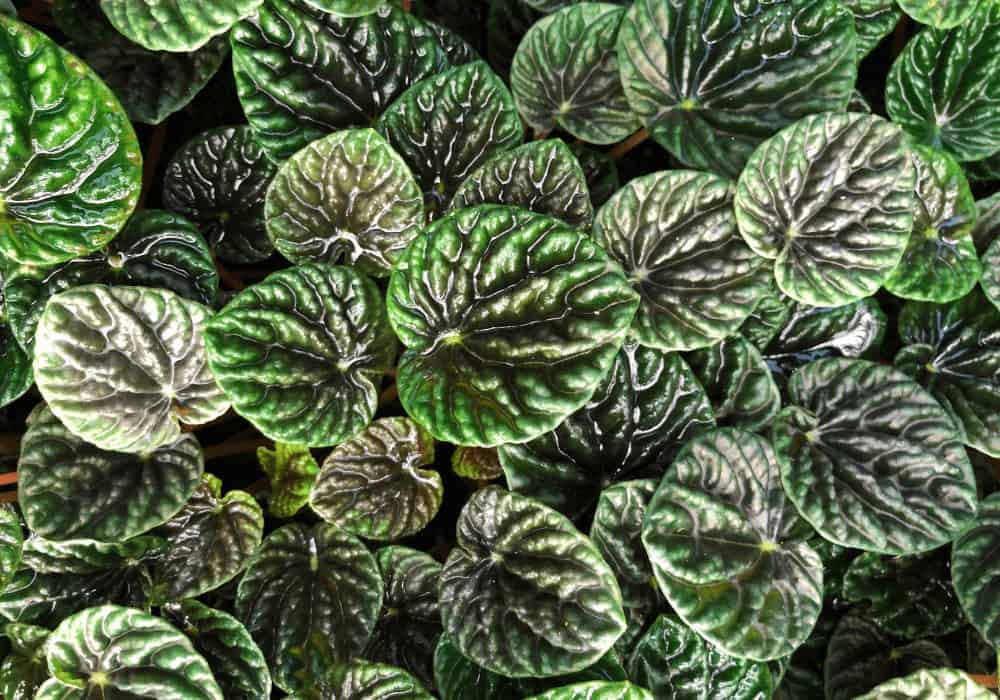
This is the most common Peperomia variety and has many cultivars like the ‘Suzanne’ and ‘Emerald Ripple.’ The emerald ripple peperomia has outstanding shiny, oval leaves with a distinct corrugated appearance.
Most cultivars of this variety have red or almost purple color, while some other cultivars have green to silver-grey with red blushing.
The Caperata doesn’t fall under the trailing peperomia variety and thus will be perfect for a shelf or tabletop. It will have to be regularly trimmed because it tends to overgrow and crowd a limited space.
In terms of care requirements, the Emerald Ripple Peperomia doesn’t require extra maintenance and will thrive with the right indirect light with moderate watering and occasional misting.
Plant in well-draining, peat-based soil for maximum results.
7. Peperomia Clusiifolia (Peperomia Jelly)

This variety of peperomia plant shares certain similarities with the Baby Rubber Plant, and it's also called red edge peperomia, Ginny peperomia, and tricolor peperomia. It has uniquely multicolored leaves that are wavy and elongated.
The leaves have a green center, cream-colored stripe patterns that fade to a pale pink around the edges.
This variety is prone to messy growth and muddy tinting and thus requires trimming as a houseplant. This variety is also a popular beginner's plant due to its high tolerance level.
They can survive in low light conditions and under artificial fluorescent lighting. However, bright indirect light is required for this plant to reach its full potential. This variety will thrive in well-draining soil — only water when the surface soil is dry.
8. Peperomia Graveolens (Ruby Glow Peperomia)
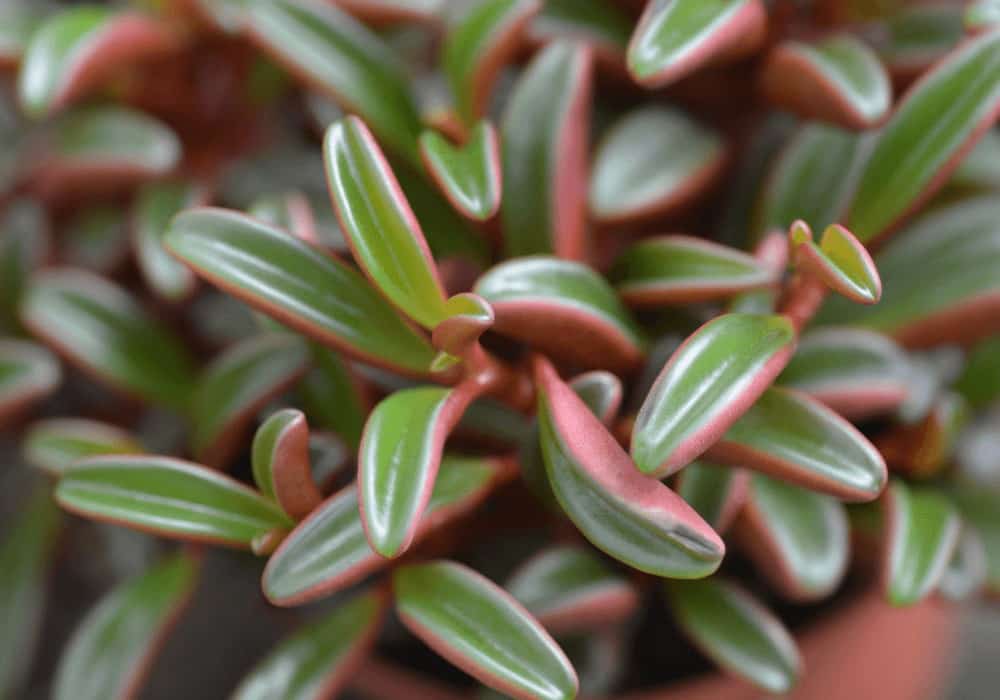
This is also a popular variety of peperomia plants and has succulent-like leaves and a compact growth form. Its light green leaves are tongue-shaped with a deep crease down the center, pink edges, and a pinkish-red underside.
This particular variety is native to dry regions of southern Ecuador and thus is ideal for low-light environments, partial sun, or even shaded areas.
The Ruby Glow Peperomia has a foul smell which is not surprising given that the meaning of graveolens in Latin is 'bad smelling.'
As a semi-succulent plant, this variety requires minimal watering and remains, and it suspectable to root rot if it's overwatered.
This variety can grow up to 25cm in size under the ideal conditions and requires well-draining soil, preferably a succulent soil mix is ideal for maximum results.
9. Peperomia Tetraphylla ‘Hope’ (Peperomia Hope)
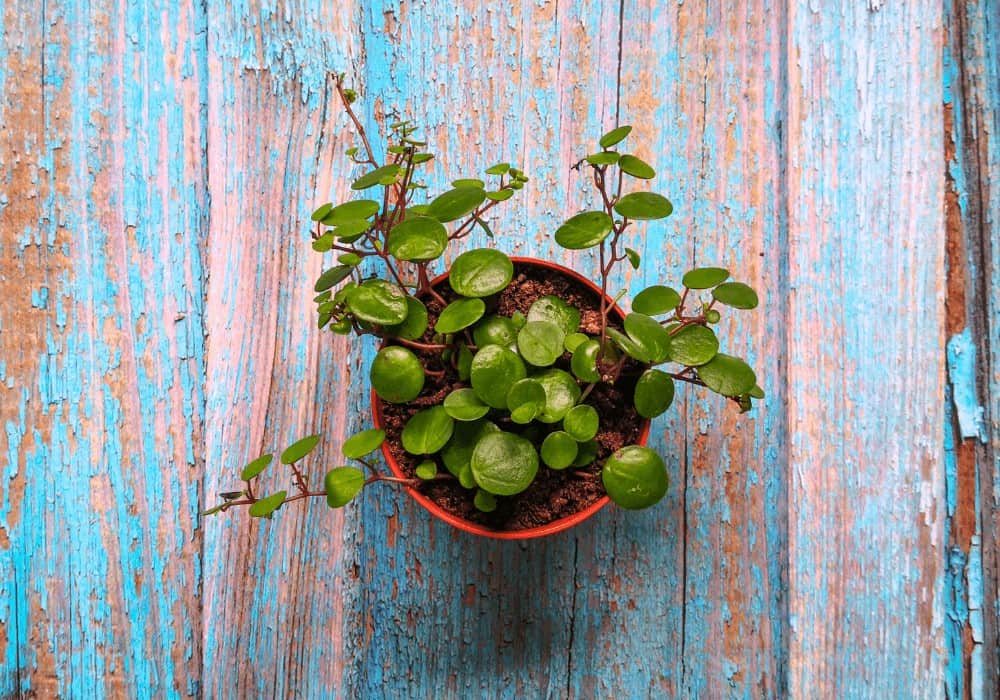
This variety is also called acorn peperomia or four-leaved peperomia and shares some similarities with the trailing jade peperomia, and it's most often confused for it probably because of its long, trailing stems and thick oval leaves.
As opposed to the trailing jade peperomia that has a bushy appearance, the Peperomia Hope tends to grow bunched in groups of 3 or 4, making it less bushy in appearance.
This variety is a hybrid of two other peperomia plants – the Peperomia deppeana and Peperomia quadrifolia.
The Peperomia Hope will thrive in low to moderate, indirect light, and well-draining soil, preferably part moss and perlite. Only water when the soil surface has dried, however, mist regularly to its humidity.
10. Peperomia Orba (Teardrop Peperomia)
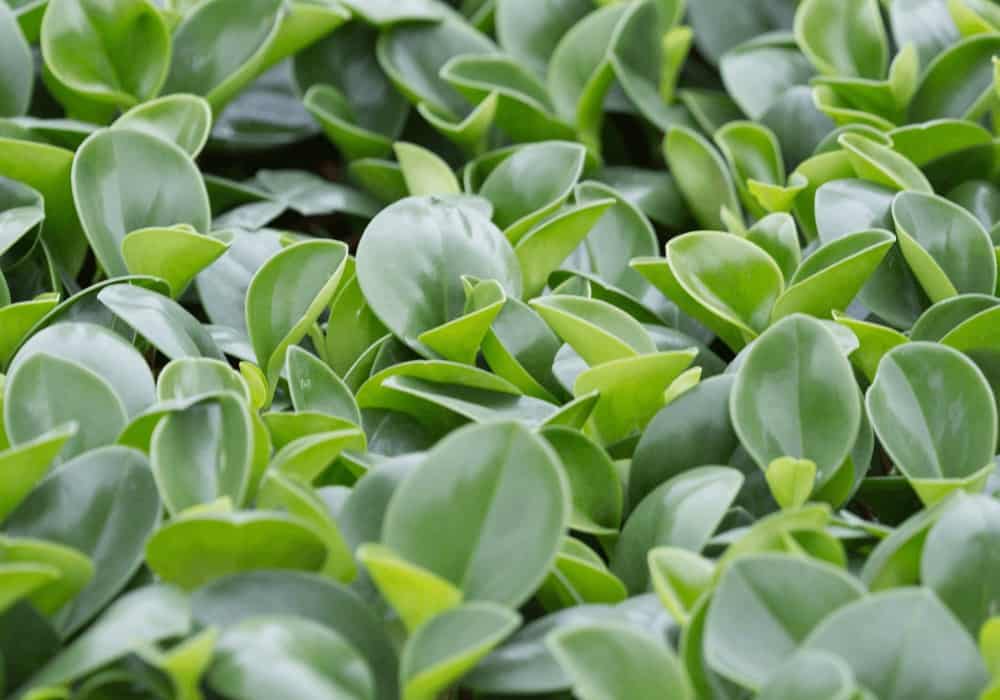
As the name suggests, the teardrop peperomias have small, oval-shaped leaves that look like teardrops. The size of the leaves varies depending on the cultivar.
They have a generally bushy appearance and come in either solid green color, light green to almost yellow, or variegated green with golden-yellow edges. A white line appears in the middle of the leaf once the plant is mature.
This plant is ideal for first-time plant owners as it is extremely easy to care for and is tolerant to neglect. The teardrop peperomia thrives with moderate light and in well-draining soil.
This variety is drought tolerant and thus should only be watered when leaves that soil surface is dried.
Conclusion
If you are in search of the perfect houseplant to spice up your décor, then peperomia is the sure way to go.
Fortunately, there are many varieties of this beautiful tropical plant perfect for every space. Some of the trailing varieties are perfect for a hanging basket!
More so, most types of peperomia are beginner-friendly, which means that even someone without a green thumb can easily care for them, probably because of their succulent-like nature.
With the help of this post, you shouldn't have any trouble choosing the best type of peperomia to enhance your garden, home, or office!
Recommended Articles:
- Types Of Lilies
- Types of Palm Trees in Florida
- Different Types of Calathea
- Different Types of Snowball Bushes
- Different Types of Plants in The Rainforest
- Hoya Krimson Princess Care




